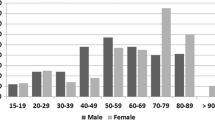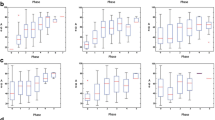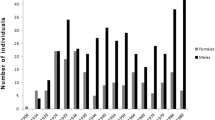Abstract
In forensic anthropology, the age-at-death of an adult individual is one of the most complex parameters of the biological profile to estimate. The present study aims to evaluate the reliability of the Calce (2012) method for the estimation of age-at-death through acetabulum changes in a sample of Portuguese origin. This method consists of the global analysis of acetabular age-related morphology with focus on three specific traits, namely the acetabular groove, the osteophyte development of the acetabular rim, and the apex growth. This method was tested in 120 individuals sampled from the Twenty-first Century Identified Skeletal Collection (University of Coimbra, Portugal). The test sample is composed of 60 males and 60 females, aged between 25 and 99 years, with well-preserved os coxae. The results showed that only 60% of the individuals were correctly attributed to the age group defined by the technique. The comparison with previous studies in other populations shows significant inter-population differences in the relationship between the acetabulum variables used by Calce and age-at-death. The obtained results advise caution in the use of the Calce (2012) method to estimate the age-at-death of unidentified skeletons.

Similar content being viewed by others
References
Dirkmaat DC, Cabo LL, Ousley SD, Symes SA (2008) New perspectives in forensic anthropology. Am J Phys Anthropol 137:33–52. https://doi.org/10.1002/ajpa.20948
Márquez-Grant N (2015) An overview of age estimation in forensic anthropology: perspectives and practical considerations. Ann Hum Biol 42:308–322. https://doi.org/10.3109/03014460.2015.1048288
Buckberry J (2015) The (mis)use of adult age estimates in osteology. Ann Hum Biol 42:323–331. https://doi.org/10.3109/03014460.2015.1046926
Rösing FW, Graw M, Marré B, Ritz-Timme S, Rothschild MA, Rötzscher K, Schmeling A, Schröder I, Geserick G (2007) Recommendations for the forensic diagnosis of sex and age from skeletons. Homo 58:75–89. https://doi.org/10.1016/j.jchb.2005.07.002
Mays S (2015) The effect of factors other than age upon skeletal age indicators in the adult. Ann Hum Biol 42:332–341. https://doi.org/10.3109/03014460.2015.1044470
Ritz-Timme S, Cattaneo C, Collins MJ, Waite ER, Schütz HW, Kaatsch HJ, Borrman HIM (2000) Age estimation: the state of the art in relation to the specific demands of forensic practise. Int J Legal Med 113:129–136. https://doi.org/10.1007/s004140050283
Cunha E, Baccino E, Martrille L, Ramsthaler F, Prieto J, Schuliar Y, Lynnerup N, Cattaneo C (2009) The problem of aging human remains and living individuals: a review. Forensic Sci Int 193:1–13. https://doi.org/10.1016/j.forsciint.2009.09.008
Franklin D (2010) Forensic age estimation in human skeletal remains: current concepts and future directions. Legal Med 12:1–7. https://doi.org/10.1016/j.legalmed.2009.09.001
Garvin HM, Passalacqua NV (2012) Current practices by forensic anthropologists in adult skeletal age estimation. J Forensic Sci 57:427–433. https://doi.org/10.1111/j.1556-4029.2011.01979.x
Rougé-Maillart C, Telmon N, Rissech C, Malgosa A, Rougé D (2004) The determination of male adult age at death by central and posterior coxal analysis: a preliminary study. J Forensic Sci 49:1–7. https://doi.org/10.1520/jfs2002056
Rougé-Maillart C, Jousset N, Vielle B, Gaudin A, Telmon N (2007) Contribution of the study of acetabulum for the estimation of adult subjects. Forensic Sci Int 171:103–110. https://doi.org/10.1016/j.forsciint.2006.10.007
Rissech C, Estabrook GF, Cunha E, Malgosa A (2006) Using the acetabulum to estimate age at death of adult males. J Forensic Sci 51:213–229. https://doi.org/10.1111/j.1556-4029.2006.00060.x
Rissech C, Estabrook GF, Cunha E, Malgosa A (2007) Estimation of age-at-death for adult males using the acetabulum, applied to four Western European populations. J Forensic Sci 52:774–778. https://doi.org/10.1111/j.1556-4029.2007.00486.x
Rougé-Maillart C, Vielle B, Jousset N, Chappard D, Telmon N, Cunha E (2009) Development of a method to estimate skeletal age at death in adults using the acetabulum and the auricular surface on a Portuguese population. Forensic Sci Int 188:91–95. https://doi.org/10.1016/j.forsciint.2009.03.019
Venara A, Martrille L, Godin M, Kerdat C, Deguette C, Chapard D, Rouge-Maillart C (2013) Estimation of skeletal age at death in adults using the acetabulum and the auricular surface – an application on the Terry collection. Rev Méd Lég 4:189–196. https://doi.org/10.1016/j.medleg.2013.08.002
Calce SE, Rogers TL (2011) Evaluation of age estimation technique: testing traits of the acetabulum to estimate age at death in adult males. J Forensic Sci 56:302–311. https://doi.org/10.1111/j.1556-4029.2011.01700.x
Calce SE (2012) A new method to estimate adult age-at-death using the acetabulum. Am J Phys Anthropol 148:11–23. https://doi.org/10.1002/ajpa.22026
Mays S (2012) An investigation of age-related changes at the acetabulum in 18th-19th century ad adult skeletons from Christ Church Spitalfields, London. Am J Phys Anthropol 149:485–492. https://doi.org/10.1002/ajpa.22146
Mays S (2014) A test of a recently devised method of estimating skeletal age at death using features of the adult acetabulum. J Forensic Sci 59:184–187. https://doi.org/10.1111/1556-4029.12293
Ferreira MT, Vicente R, Navega D et al (2014) A new forensic collection housed at the University of Coimbra, Portugal: the 21st century identified skeletal collection. Forensic Sci Int 245:202.e1–202.e5. https://doi.org/10.1016/j.forsciint.2014.09.021
Cohen J (1960) A coefficient of agreement for nominal scales. Educ Psychol Meas 20:37–46. https://doi.org/10.1177/001316446002000104
Cohen J (1968) Weighted kappa: nominal scale agreement with provision for scaled disagreement or partial credit. Psychol Bull 70:213–220
Bhapkar VP (1966) A note on the equivalence of two test criteria for hypotheses in categorical data. J Am Stat Assoc 61:228–235. https://doi.org/10.1080/01621459.1966.10502021
Bishop YM, Light RJ, Mosteller F (2007) Discrete multivariate analysis: theory and practice, 2nd edn. Springer, New York
Cover TM, Thomas JA (2005) Elements of information theory, 2nd edn. Wiley, Hoboken
Powers D (2011) Evaluation: from precision, recall and F-measure to ROC, informedness, markedness & correlation. J Mach Learn Technol 2:37–63
Landis JR, Koch GG (1977) The measurement of observer agreement for categorical data. Biometrics 33:159–174. https://doi.org/10.2307/2529310
Rissech C (2013) Letter to the editor: comments on “a new method to estimate adult age-at-death using the acetabulum” (Calce, 2012). Am J Phys Anthropol 151:331–332. https://doi.org/10.1002/ajpa.22265
Calce SE (2013) Notes and comments: reply to Rissech’s letter. Am J Phys Anthropol 151:333–334. https://doi.org/10.1002/ajpa.22271
Botha D, Pretorius S, Myburgh J, Steyn M (2016) Age estimation from the acetabulum in South African black males. Int J Legal Med 130:809–817. https://doi.org/10.1007/s00414-015-1299-7
San-Millán M, Rissech C, Turbón D (2017) New approach to age estimation of male and female adult skeletons based on the morphological characteristics of the acetabulum. Int J Legal Med 131:501–525. https://doi.org/10.1007/s00414-016-1406-4
Milner GR, Boldsen JL (2012) Transition analysis: a validation study with known-age modern American skeletons. Am J Phys Anthropol 148:98–110. https://doi.org/10.1002/ajpa.22047
Navega D, Coelho J, d’Oliveira Cunha E, Curate F (2017) DXAGE: a new method for age at death estimation based on femoral bone mineral density and artificial neural networks. J Forensic Sci 63:497–503. https://doi.org/10.1111/1556-4029.13582
Miranker M (2016) A comparison of different age estimation methods of the adult pelvis. J Forensic Sci 61:1173–1179. https://doi.org/10.1111/1556-4029.13130
Funding
The co-authors David Navega [SFRH/BD/99676/2014] and Maria Teresa Ferreira [SFRH/BPD/11710/2015] were financed by Fundação para a Ciência e Tecnologia.
Author information
Authors and Affiliations
Corresponding author
Ethics declarations
Conflict of interest
The authors declare that they have no conflict of interest.
Rights and permissions
About this article
Cite this article
Navega, D., Godinho, M., Cunha, E. et al. A test and analysis of Calce (2012) method for skeletal age-at-death estimation using the acetabulum in a modern skeletal sample. Int J Legal Med 132, 1447–1455 (2018). https://doi.org/10.1007/s00414-018-1902-9
Received:
Accepted:
Published:
Issue Date:
DOI: https://doi.org/10.1007/s00414-018-1902-9




